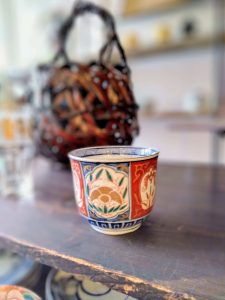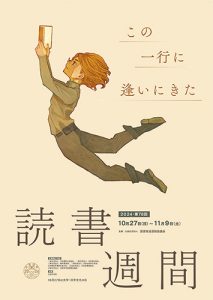読書の秋していますか?(愛知県名古屋市千種区姫池通 骨董買取 古美術風光舎)
2024.10.27
皆さまこんにちは。スタッフTでございます。
夜が長くなり、朝晩もずいぶんと涼しくなりました。さて、本日は「読書の日」でございます。涼しくなると、頁をめくる手もはかどるような気がしますね。皆さまは、読書の秋、されていますか?

読書と秋、相性がいいと言われるようになったのは、ずいぶん昔のことのようです。
「読書の秋」という言葉は、唐の文人の韓愈(かんゆ/768−824年)の詩『符読書城南(符、書を城南に読む)』の中に出てくる一節がもとになっているようです。
時秋にして積雨(せきう)霽(は)れ
新涼郊墟(しんりょうこうきょ)に入(い)る
燈火稍(やや)親しむ可(べ)く
簡編卷舒(かんぺんけんじょ)す可(べ)し
「秋になり、長雨も晴れ上がって、新鮮な涼しい気が城外の村の家々に入り込むようになった。夜には明かりにも親しめるようになったので、これからは書物をひもとくこともできるだろう」といった意味ですが、はるか昔の人びとも、暑い夏が過ぎゆっくり読書できる秋が訪れることを、よろこんでいたのでしょうか。
日本では、明治の文豪である夏目漱石が1908年に発表した小説『三四郎』のなかで韓愈(かんゆ)の詩を引用したことで、秋は読書をするというイメージが一気に日本中に広まり、「読書の秋」の考えや習慣が日本に根付いたと考えられています。
第1回の読書週間が開催されたのは、終戦まもない1947(昭和22)年の頃。「読書の力によって、平和な文化国家を作ろう」という志のもと、出版社や取次会社、書店、公共図書館を中心に、新聞社や放送局なども協力して行われました。
そしてこの「読書週間」にあたって、毎年、本や読書をテーマにした標語とポスターが作られているのはご存知でしょうか。今年選ばれたのは
『この一行に逢いにきた』だそうです。

ふと気になって、今までの標語はどんな感じだったのかと調べてみると、記念すべき第1回の標語は「楽しく読んで 明るく生きよう」(1947)でした。なにげなく「生きよう」なんて言葉が出てくるところが戦後らしいような気がします。
ここから60年代ぐらいまでは真面目な感じで、「そろって読書 明るい家庭」(1957)、「読書でつくろう 明るい社会」(1958)などがあります。本を読んで明るい家庭ができるかどうかは疑問なところですが、こういう前向きな感じが当時の雰囲気なのでしょうか。
70年代に入ると、もう少し個人的で、読書があなたの人生を豊かにしてくれるといったニュアンス。「本との出会い 豊かな心」(1974)、「本との出会い ゆたかな時間」(1975、76)など。
80年代の後半からは、どちらかというと表現がもっと感覚的なというか、オシャレな感じです。標語というよりは「コピー」と言っていいかもしれません。
「秋が好き。街が好き。本が好き。」(1989)「本を読んだね! いい顔してるよ」(1995)「おかえり、栞の場所で待ってるよ」(2019)などなど。なかなか面白いのでもっと紹介したいところですが、ひとまずこれくらいに。
共通したものはなさそうですが、なにか目的や意義があるから本を読むというのではなくて、純粋に本を読むことが好きという感情を表現しているような感じでしょうか。
それぞれの時代で、読書に求められているものが少しずつ違うのが分かるような分からないような。標語だけでなくポスターも興味深いので、ご興味ある方はぜひ見てみてください。
本を手に取ってみたくなるかもしれませんよ。
ではでは、また。
Hello everyone. This is Staff T.
The nights are getting longer and the mornings and evenings have become much cooler. Today is “Reading Day. I feel that the cooler weather makes me more motivated to turn the pages of a book. Is everyone reading in the fall?
It seems like it was a long time ago that people started to say that reading and autumn go hand in hand.
The phrase “autumn for reading” seems to be based on a line from a poem by Han Yu (768-824), a Tang Dynasty writer, in his work “Tui yinsho seongnam (Read books in seongnam)”.
In autumn, when the rain is clear and the sky is clear
Entering the new cool suburbs
A little more light will be on
You should have a brief millstone release
It was autumn, the long rain had cleared up, and fresh, cool air began to enter the houses in the villages outside the castle. The word “autumn” means, “Now that the long rain has cleared up, fresh cool air is entering the houses in the villages outside the castles, and we can enjoy the light at night, we will be able to read books from now on.
In Japan, it is believed that the idea and custom of “autumn for reading” took root in Japan when Soseki Natsume, a great writer of the Meiji era, quoted a poem by Han Yu in his novel “Sanshiro” published in 1908, and the image of reading in autumn spread throughout Japan at once.
The first Reading Week was held in 1947, shortly after the end of the war. The first Reading Week was held in 1947, shortly after the end of the war, with the aim of “creating a peaceful cultural nation through the power of reading.” Publishers, distributors, bookstores, and public libraries played a central role, with the cooperation of newspaper companies and broadcasting stations.
Did you know that every year, a slogan and poster are created around the theme of books and reading during “Reading Week”? This year, the following mottoes and posters were chosen
This year’s chosen motto was “I came to meet this one line.
I was curious and looked up the previous mottoes, and found that the memorable first motto was “Read happily and live brightly” (1947). The casual appearance of the word “live” seems to me to be typical of the postwar period.
From this point until about the 1960s, the first mottoes were more serious, such as “Let’s read together to create a cheerful family” (1957) and “Let’s create a cheerful society by reading books” (1958). It is questionable whether reading books can create a cheerful family, but this kind of positive feeling was probably the atmosphere of the time.
In the 70’s, the tone is a bit more personal, with the nuance that reading enriches your life. In the 70’s, the tone was a little more personal, with a more “book encounter” feel, such as “Encounters with Books: A Rich Mind” (1974) and “Encounters with Books: A Wonderful Time” (1975, 1976).
From the latter half of the 1980s, the expressions are rather more sensual or fashionable. Rather than mottoes, they could be described as “copy.
I love autumn. I love the city. I love books.” (1989) “You read books! You look good” (1995), ‘Welcome back, I’ll be waiting for you at the bookmark place’ (2019), and so on. They are quite interesting and I would like to introduce more, but that’s enough for now.
There doesn’t seem to be anything in common, but I think they express the pure love of reading books, rather than reading books for some purpose or significance.
It seems as if they are expressing a pure love of reading books, rather than reading books for any purpose or significance. The posters as well as the mottoes are interesting, so please take a look if you are interested.
You may be tempted to pick up a book.
See you soon.
*******************
ご実家の整理やお片付けなどをされている方のご相談などが多くございます。
お片付けなどくれぐれもご無理のないようになさってくださいませ。
風光舎では古美術品や骨董品の他にも絵画や宝石、趣味のお品など様々なジャンルのものを買受しております。
お片付けをされていて、こういうものでもいいのかしらと迷われているものでも、どうぞお気軽にご相談下さいませ。
また風光舎は、出張買取も強化しております。ご近所はもちろん、愛知県内、岐阜県、三重県その他の県へも出張いたします。
まずは、お電話お待ちしております。
愛知県名古屋市千種区姫池通
骨董 買取【古美術 風光舎 名古屋店】
TEL052(734)8444
10:00-17:00 OPEN
#出張買取#骨董#古美術#骨董品#絵画#版画#茶道具#刀剣#彫刻

